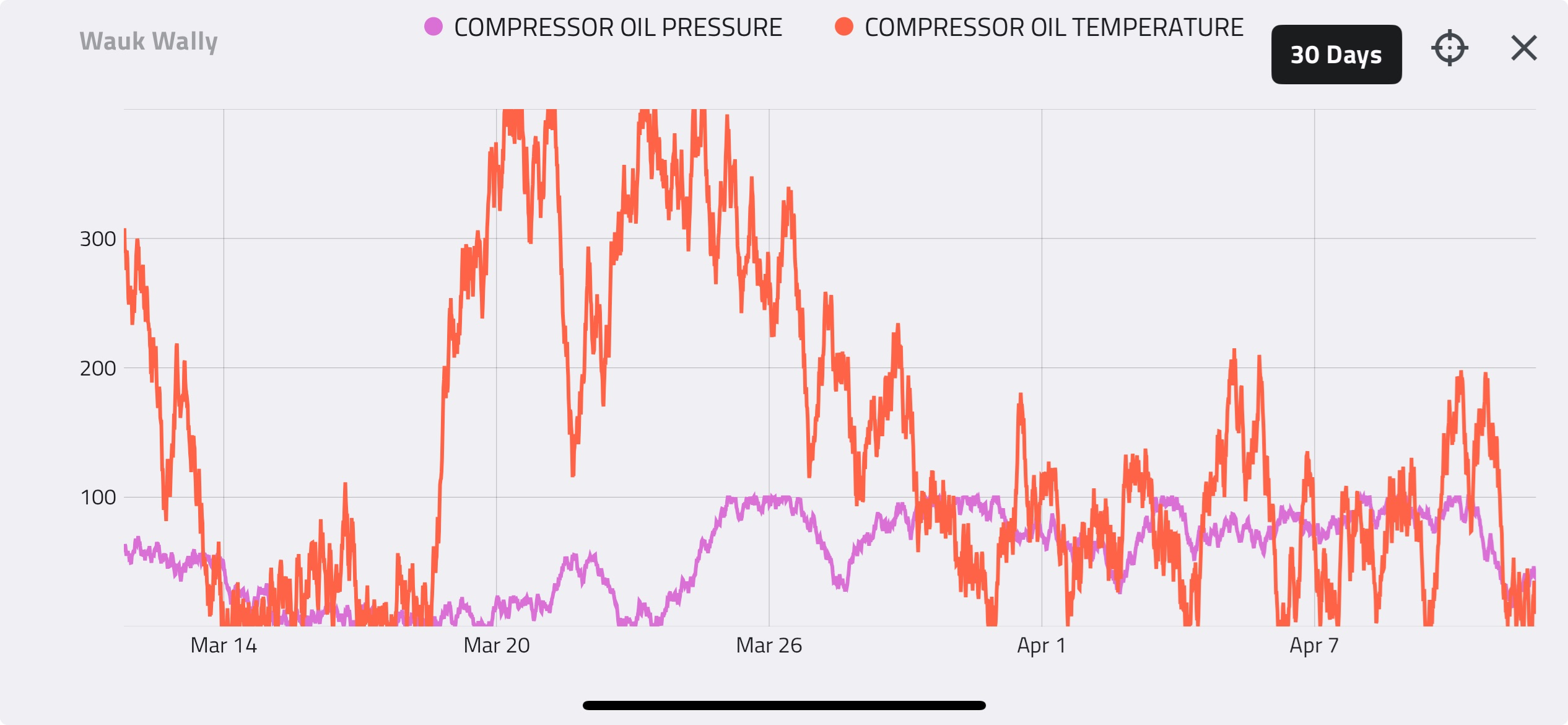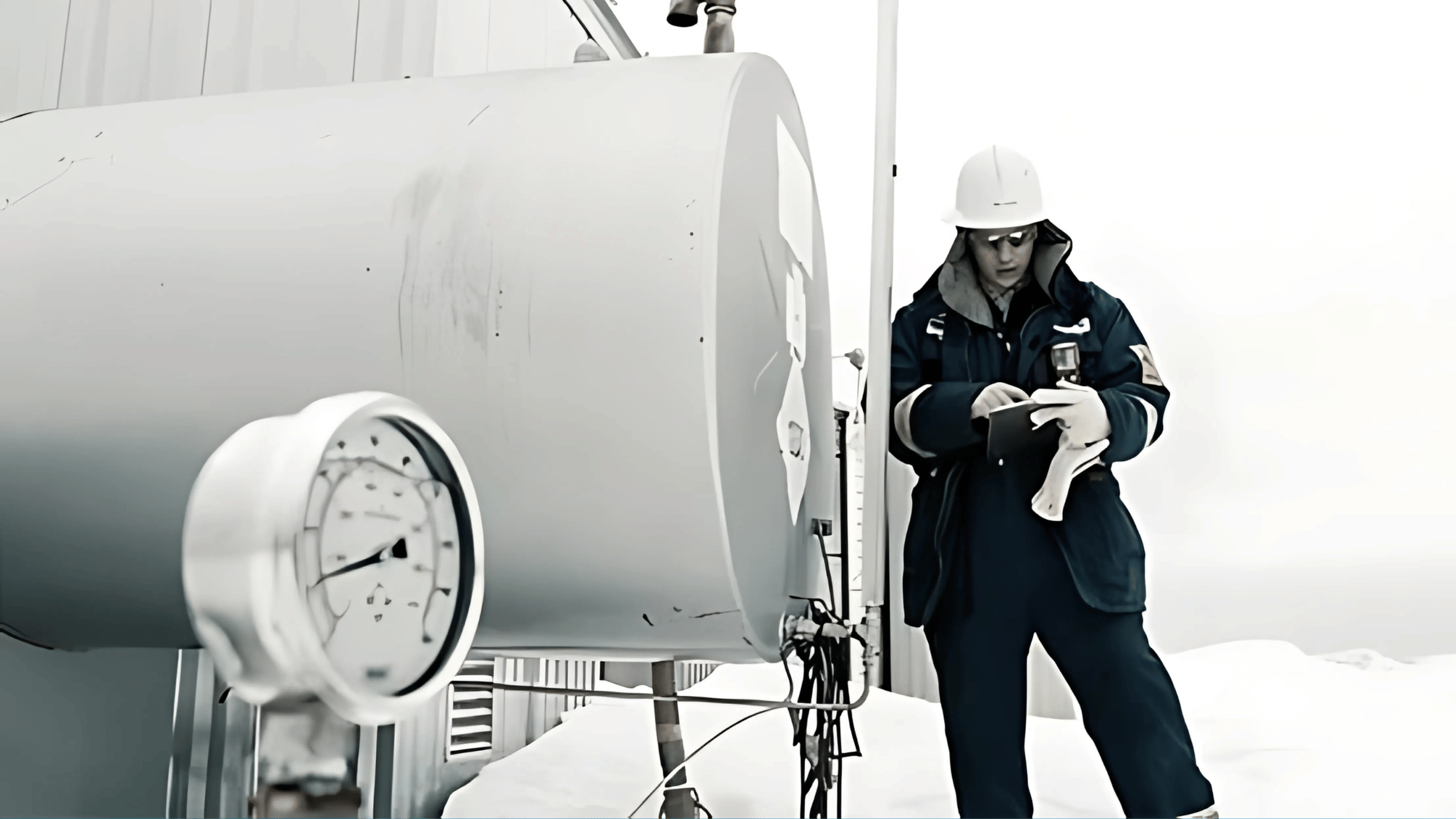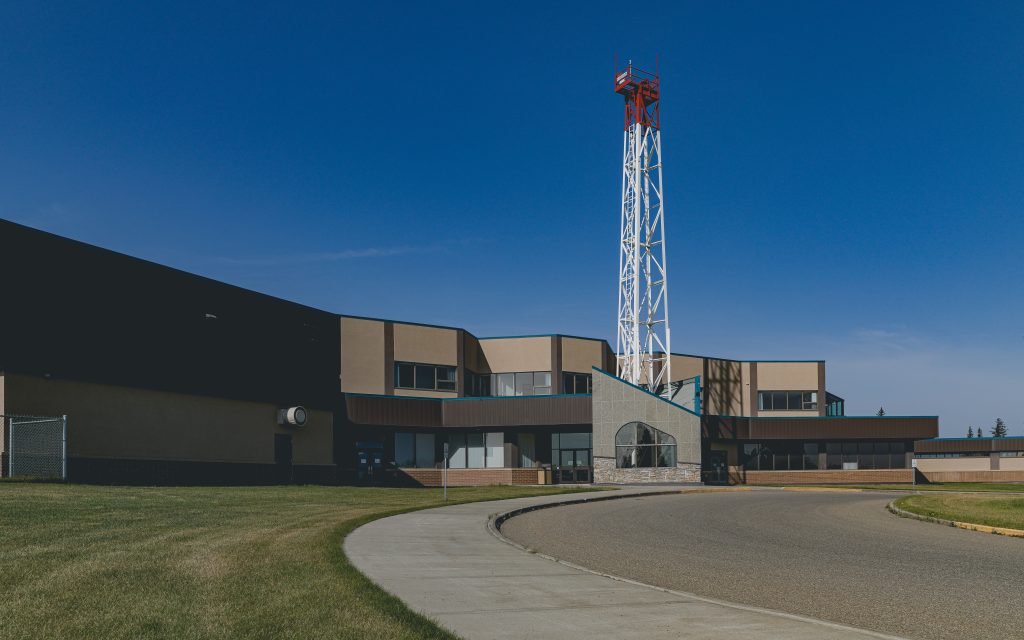Houston, TX |
- Thought of the Day: Aligning Business Objectives When Natural Gas Producers Lease Compression Assets
- Representative Win: Increased Throughput – Maximizing Power Usage
- Tech Tip: The Optimization Life-Cycle
Thought of the Day
Aligning Business Objectives When Natural Gas Producers Lease Compression Assets
The line between operational and maintenance responsibility is often blurred when managing a fleet of compression assets. Additional complexity is introduced when some of the assets are owned and some are leased. In this quarter’s blog, we will look at the different philosophies and metrics for operating and maintaining a fleet of leased compression assets.
When a natural gas production company leases compression assets to service their gathering network, they generally agree to service level agreements around availability and mechanical availability with the compression leasing company.
Availability is generally defined as:
| Total Available Runtime Hours – Total Downtime Hours |
| Total Available Runtime Hours |
Total downtime hours include both scheduled downtime for preventative maintenance and compressor overhauls as well as unscheduled downtime for any reason not associated with scheduled downtime.
Mechanical availability is generally defined as:
| Total Available Runtime Hours – Downtime Hours Due to Mechanical Issues |
| Total Available Runtime Hours |
The natural gas producer and the compression leasing company agree to terms and service levels around these two metrics and then move to operations. However, these two metrics do not take into account the level of efficiency or utilization that each compressor has delivered for each hour of runtime. Consequently, a leasing company may meet their contractual guarantees of availability and mechanical availability, while opportunities around process losses and inefficiencies caused by the mechanical conditions inside each compressor and cylinder go unrealized as that responsibility remains with the entity responsible for operations. It is in these instances that Detechtion can help bridge the gap between maintenance and operational philosophies. Using Enalysis™, we can help leasing companies meet their service level agreements around availability and mechanical availability and highlight utilization opportunities that can be acted upon and realized by operations.
When a natural gas producer deploys Enalysis™ on those leased assets, operational opportunities that either increase throughput or save on power consumption are quickly identified. These opportunities are sent to the compression leasing company and natural gas producer. Depending on who is responsible for operations dictates how those opportunities are realized.
In a best practice we have observed, there are joint monthly meetings with the leasing company, operating company and Detechtion to ensure that business objectives are aligned. At these monthly meetings, opportunities for increased gas throughput (along with recommended operating changes like pocket adjustments, speed changes, etc.), power savings, and any inefficiencies identified through Enalysis™ are jointly reviewed and prioritized. Whether implemented by the leasing company or by the operator, the benefits are significant. We have found that utilization opportunities average about 1.5% of daily throughput and power savings average about 6% annually.
By deploying Enalysis™ on leased compression assets, natural gas producers can then feel confident that they are getting the most out of their compression investment and the leasing company can drive towards that peak efficiency with the confidence that they are not exposing their compression assets to extreme conditions as they move towards increased availability and mechanical availability through predictive maintenance analytics.
If you are a natural gas producer who leases compression assets or the leasing company that provides them and want to make sure that utilization of those assets is being measured and acted upon, please reach out to us at Detechtion so we can quantify what opportunities exist in a leased compression fleet.
Representative Win
Increased Throughput – Maximizing Power Usage
Proposed
Optimize the client’s compressor station to maximize production and increase overall utilization.
Background
A compressor station composed of two identical reciprocating compressors was commissioned in a high activity field aimed to accommodate high flow rates and variable conditions. Cylinder actions were setup as single-acting to accommodate the variable conditions resulting in high uptime, and swinging gas flow rates. The subsequent year, activity in the field slowed and the rates/pressures steadied. With the steadied pressures and slowly declining gas rates, the two compressors became ideal candidates for optimization as identified through Enalysis™’ Cash Flow at Risk and Incremental Production calculations.
In an on-going effort to improve on and meet production targets, the gas producer opted to pursue the potential for increased production through compressor optimization.
Optimization Methodology
For a reciprocating compressor to be fully optimized for maximum throughput, either or both of the cylinder capacity utilization and the horsepower utilization should be 100%. Through the use of individual compressor performance curves, such as the one below, and a Detechtion Technologies’ Start-up Package of high and low pressure set points, detailed in this edition’s Tech-Tip, compressor units can be evaluated for opportunities to:
- Increase running speed
- Adjust cylinder action
- Reduce added cylinder clearance
- Optimize suction pressure
- Decrease recycle set point
Thus resulting in increased utilization and maximum throughput.
Outcome
After a detailed review of the current compressor station operating parameters through Detechtion Technologies’ Enalysis™ system, a new configuration with new high and low pressure set points were presented to the gas producer. With the new configuration, the compressors were capable of flowing more gas at much lower suction pressures than the current plant inlet pressure.
The new pressure set points were programmed into each panel to protect the compressors, the stage 1 cylinders were changed to double acting from single acting, the pockets were adjusted to 1.75” and the suction set-point decreased by 23 psig to pull harder on the field and increase production.
The changes resulted in approximately 4.6 mmscfd of additional throughput for the station as the field production was stimulated by the lower suction pressure. For the time frame that was closely observed, the units sustained an average production increase of 4.6 mmscfd over the following 30 days, equating to an immediate $414,000 in revenue increase for the time frame observed, assuming $3.00/mscf that, when annualized, resulted in $5,037,000 in increased revenue!
| Compressor Configurations | Power Usage | Suction Pressure | Discharge Pressure | Station Throughput | |
|---|---|---|---|---|---|
| Before | SAHE0”,SAHE0”//DA0”//DA0” | 74% | 75psig | 750psig | 11.0mmscfd |
| After | DA1.75”,DA1.75”//DA0”//DA0” | 96% | 52psig | 750psig | 15.6mmscfd |
| Change | +22% | -23psig | 0psig | +4.6mmscfd | |
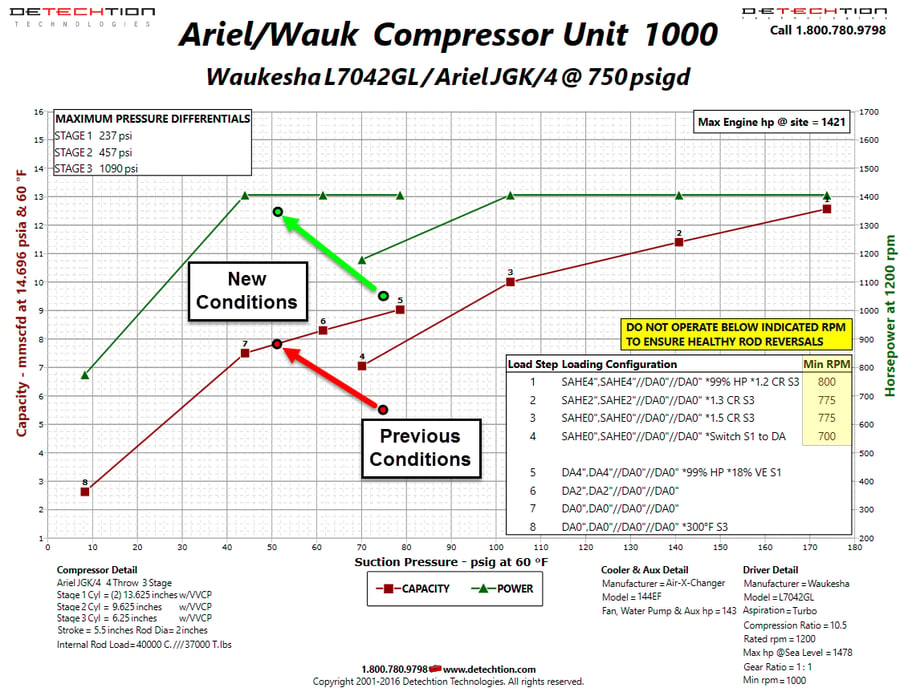
Tech Tip
The Optimization Life-Cycle
Compressor optimization is an ongoing process aiming to maximize production revenues while minimizing operating costs, all the while holding safety paramount. The engineering approach and delivery to achieve compressor optimization will vary on a case-by-case basis, while the workflow process often remains the same:
- Identify Opportunity
- Define Optimization Objectives
- Create Solution – Start-up Package
- Track Results
The steps above highlight the basic framework needed to assess an optimization opportunity. Often times, there are restrictions set by existing business processes, upstream/downstream conditions, parallel/series compression, or facility limits which must also considered but are not detailed in this article. It is important to consider the impact of any process change, in order to anticipate the expected benefit and risk as part of any management of change (MOC) process. With proper planning and execution, compressor optimization often results in a high value return for low cost efforts!
- Identify Opportunity
Finding an opportunity is the first step in optimizing a compressor. Whether you are regularly assessing Enalysis™ reports or closely monitoring its operation, here are some questions you can ask yourself to see if an opportunity presents itself:
- Is your compressor not meeting the defined objectives it was set out to do?
- Is your compressor bypassing or pinching back the suction control valve often?
- Is your compressor frequently hitting alarm set points?
- Does your Enalysis™ report frequently indicate CFRs or other flags?
If the answer to any of these questions is yes, then you might have an opportunity to improve production or reduce your operating costs!
- Define Optimization Objectives
Defining the ideal outcome beforehand can determine the success of the opportunity early on. Accommodating additional production, allowing for increased line pressure, or improving on the current operation are all common scenarios that can typically be defined with some accuracy. By considering a range of operating conditions, we can setup a compressor more capable of handling a multitude of conditions.
When given a range of potential operating conditions, Detechtion will often focus on accommodating a wider array of conditions, instead of running at a fixed point. The reason being is that compressors are often subjected to variable conditions, and any time a compressor pinches back gas with the suction control valve or recycles to regulate pressures, efficiency is lost.
- Create Solution – Start-up Package
Using Detechtion’s Curves, Online Simulator, or reaching out to your Engineering Account Manager will enable you to find the optimal solution for your compressor. Assuming we have a 3-stage compressor, and are setting up the compressor to handle the 8 to 10 mmscfd at a discharge pressure range of 700 to 1100psig, Enalysis™' Simulator determined the ideal configuration to be DA2”, DA2"//DA0"//DA0" with the limiting factor being 99% HP Utilization. Upon finding the ideal configuration, we need to verify the compressor can handle the other operating conditions, and make sure we are going to be satisfied with the outcome.
| Variable | Min | Average | Max |
|---|---|---|---|
| Configuration | DA2",DA2"//DA0"//DA0" | ||
| Discharge Range (psig) | 700 | 1000 | 1100 |
| Flow Range (mmscfd) | 8 | 9 | 10 |
| Suction Pressure (psig) | 58 | 67 | 77 |
| HP Utilization (%) | 77% | 91% | 99% |
Running two more simulations as seen in the above chart proves that we can operate in our desired minimum to maximum range. The next step is to determine the full operating range for our compressor with the creation of a start-up package.
Detechtion produces start-up packages for our clients which is a document that details the configuration, control points, and shutdown set points required for the compressor to run optimally. The start-up package considers the full range of pressures that the compressor could operate in and limits the conditions so that it will not exceed any potentially catastrophic conditions. For example; Rod Loads, net rod loads, reversals, and low volumetric efficiencies, are factors not visibly evident but could have catastrophic results if not considered.
The process for creating a start-up package may differ depending on your equipment, maintenance practices and/or operating philosophies. The process that Detechtion typically follows is detailed as follows and is based on 4 operating points:
| Limiting Factors/Objectives | High Shutdowns | High Suction Control |
|---|---|---|
| Keep Driver Utilization | <105% | <99% |
| Keep Rod Loads | <95% | <90% |
| Keep Reversals | <65% | <70% |
| Corresponding Load Step | 1 | 2 |
| Limiting Factors/Objectives | Low Suction Bypass | High Suction Control |
|---|---|---|
| Keep Discharge Temperatures | < Max Allowable | < Max Allowable |
| Keep Volumetric Efficiencies | >20% | >16% |
| Keep HP Utilization | >30% | >25% |
| Keep Rod Loads | <90% | <95% |
| Corresponding Load Step | 4 | 6 |
Using these 4 operating points as our limiting factors, the following start-up package was created and represents the full operating range along with the control points and shutdowns for our chosen configuration. This documentation and knowledge can now be handed off to the personnel responsible for completing the MOC review and making the adjustments:
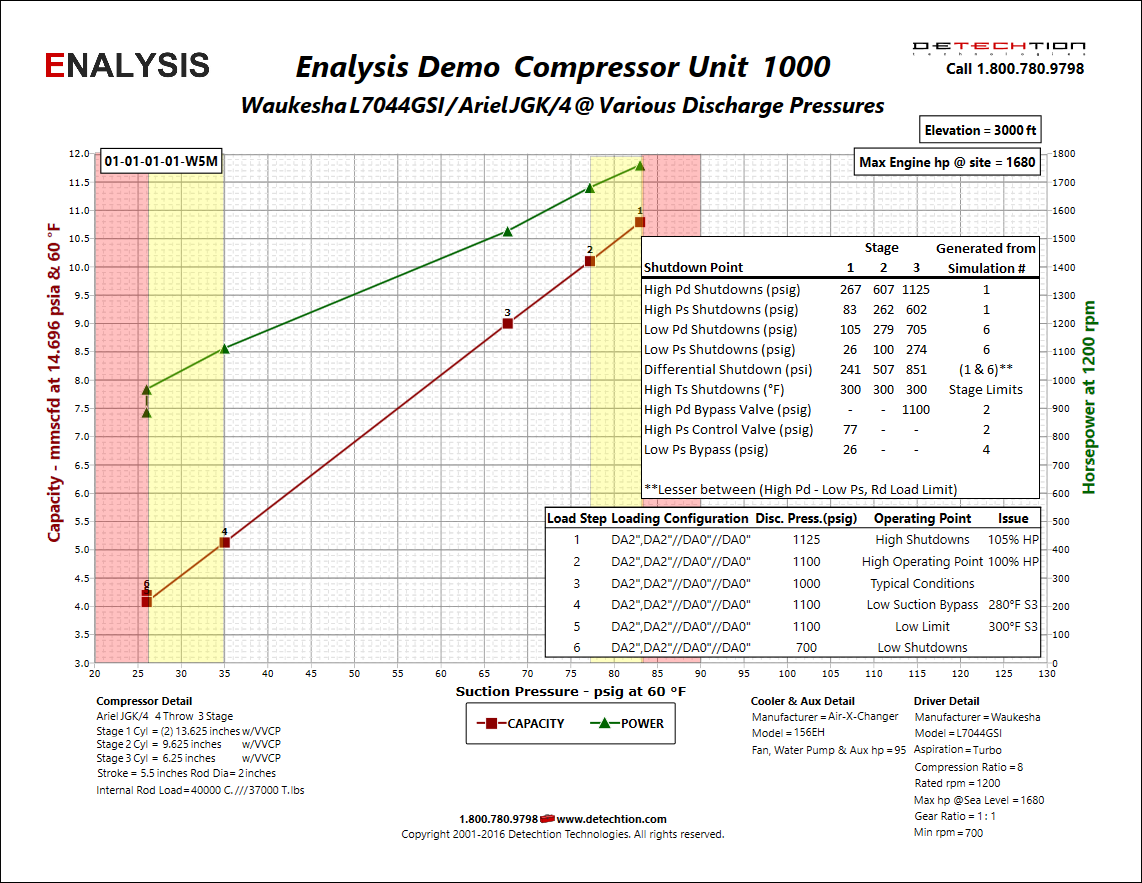
Although the objective only required the asset to move between 8-10mmscfd at a 700-1100 psig discharge pressure, the above start-up package indicates that if needed, the compressor can handle flow between 5-10 mmscfd, between a range of 35-77 psig suction pressure while protecting the units if these wider ranges are exceeded. The wider operating band will keep the unit out of recycle ultimately improving the unit’s overall efficiency.
- Track Results
After the changes have been made and the compressor is optimized, it is important to ensure that the results were as expected. Detechtion has numerous approaches to assessing the benefits of a configuration change which involves assessing changing trends, verbal feedback, or looking over a time period. Assuming the data is available, comparing the 30 days before and after the optimization provides an excellent resource for assessing the overall outcome of the change and whether or not the opportunity was acted on effectively or if further opportunities exist for optimization.
| Key Performance Indicator | 30 Day Before | 30 Day After | Change | Comment |
|---|---|---|---|---|
| Average Production (mmscf) | 9 | 9.2 | 0.2 | $12,000/month Production Gain (@2.00/mscf) |
| Average Suction Pressure (psig) | 70 | 66 | -4 | |
| Average Discharge Pressure (psig) | 1000 | 1000 | 0 | |
| Average HP Utilization (%) | 85 | 92 | 7 | $1,020/month increase to fuel cost (@2.00/mscf) |
| Average Fuel Usage (mscf) | 212 | 229 | 17 | |
| Downtime (hrs) | 18 | 6 | -12 | $xx,xxx/month saved in personnel callouts |
If you are happy with the results, it is time to give those involved a pat on the back for creating positive results, continue monitoring the asset, and look for the next opportunity!




